Abstract
A wide range of clinical findings was present in 58 near-miss sudden infant death syndrome (SIDS) infants and 6 surviving twins of SIDS siblings. Specific investigations included: studies of gastro-oesophageal reflux and aspiration (24-hour oesophageal pH recordings, barium swallow, radionuclide 'milk-scan'); polygraphic studies of breathing, reflux, and sleep state; studies of upper airways disease (lateral airways radiography and endoscopy); detection of seizure activity by electroencephalography; evaluation of thiamine status by erythrocyte transketolase activity of venous blood. Thiamine deficiency was found in 12 of 43 tested infants; 5 of the deficient infants had a familial history of SIDS. Many potential mechanisms for asphyxia were found: idiopathic central apnoea (7 infants), tracheal obstruction from minimal tracheomalacia or aberrant innominate artery (4 infants), temporal lobe or generalised seizures (6 infants), gastro-oesophageal reflux (55 infants) with intrapulmonary aspiration (11 infants). The high incidence, severity, and timing of reflux were new findings. Reflux occurred in active and indeterminate sleep, but not in quiet sleep. The depression of respiratory reflexes by active sleep stresses the vulnerability to asphyxia. Two factors suggest that near-miss episodes are related to SIDS: the similar age distribution but earlier occurrence of near-miss episodes compared with age at death of SIDS infants, and the subsequent sudden death of 2 infants whose necropsies were consistent with SIDS.
Full text
PDF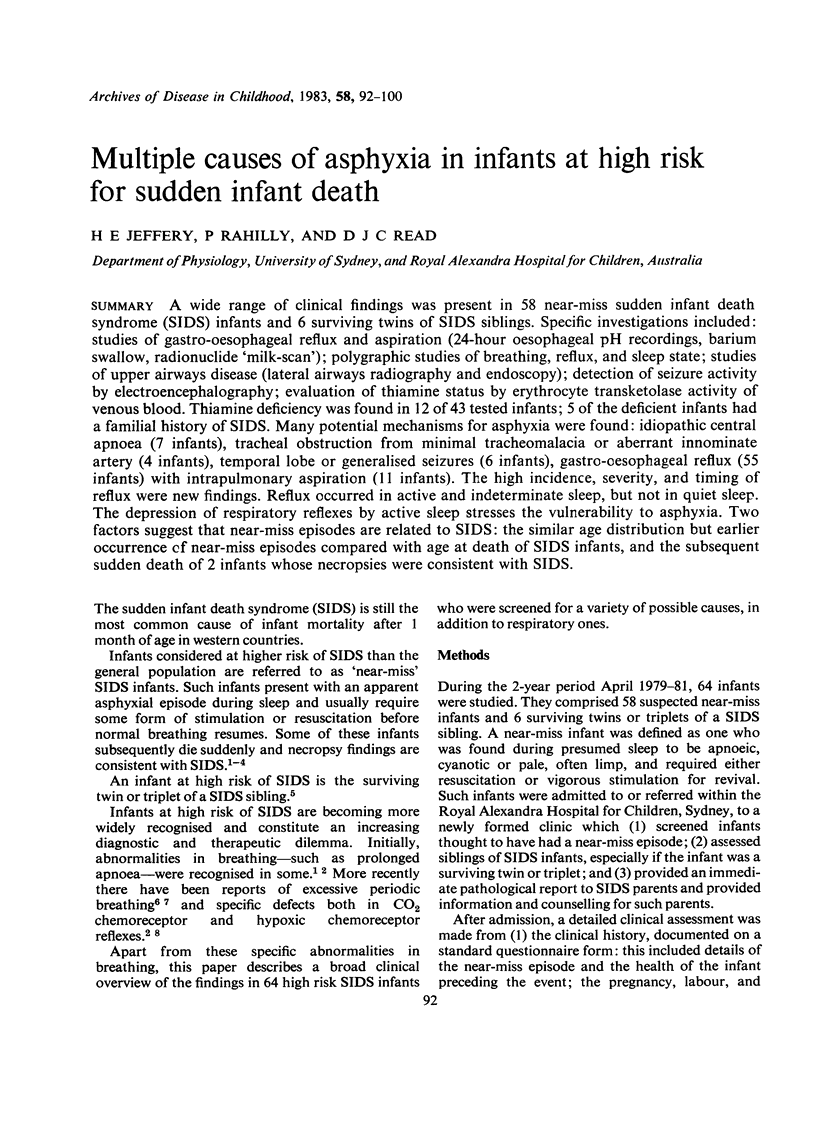
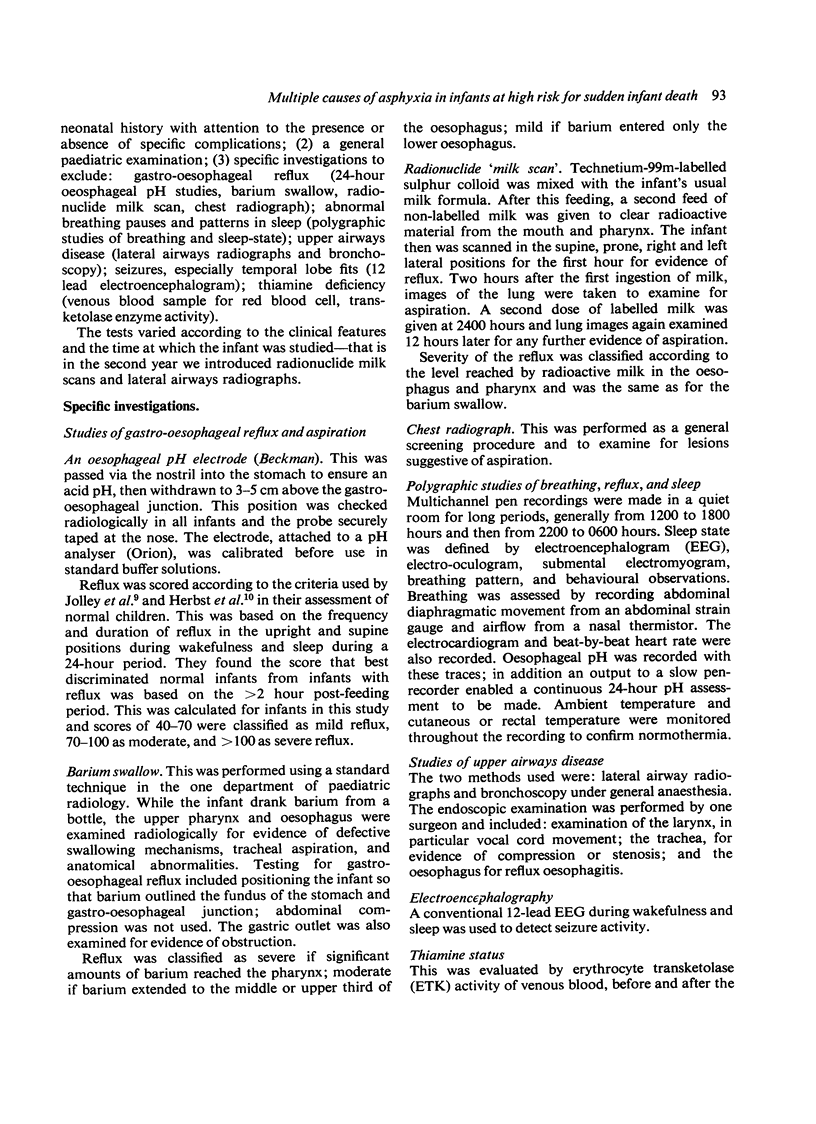
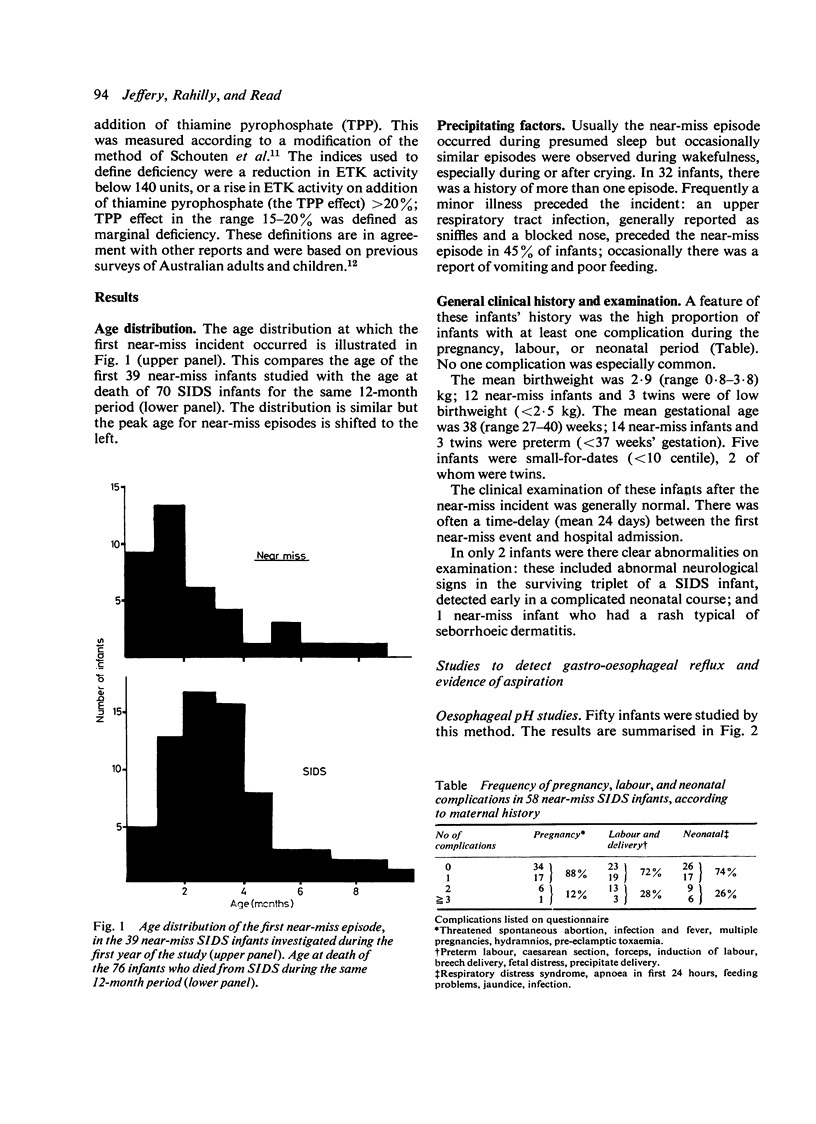
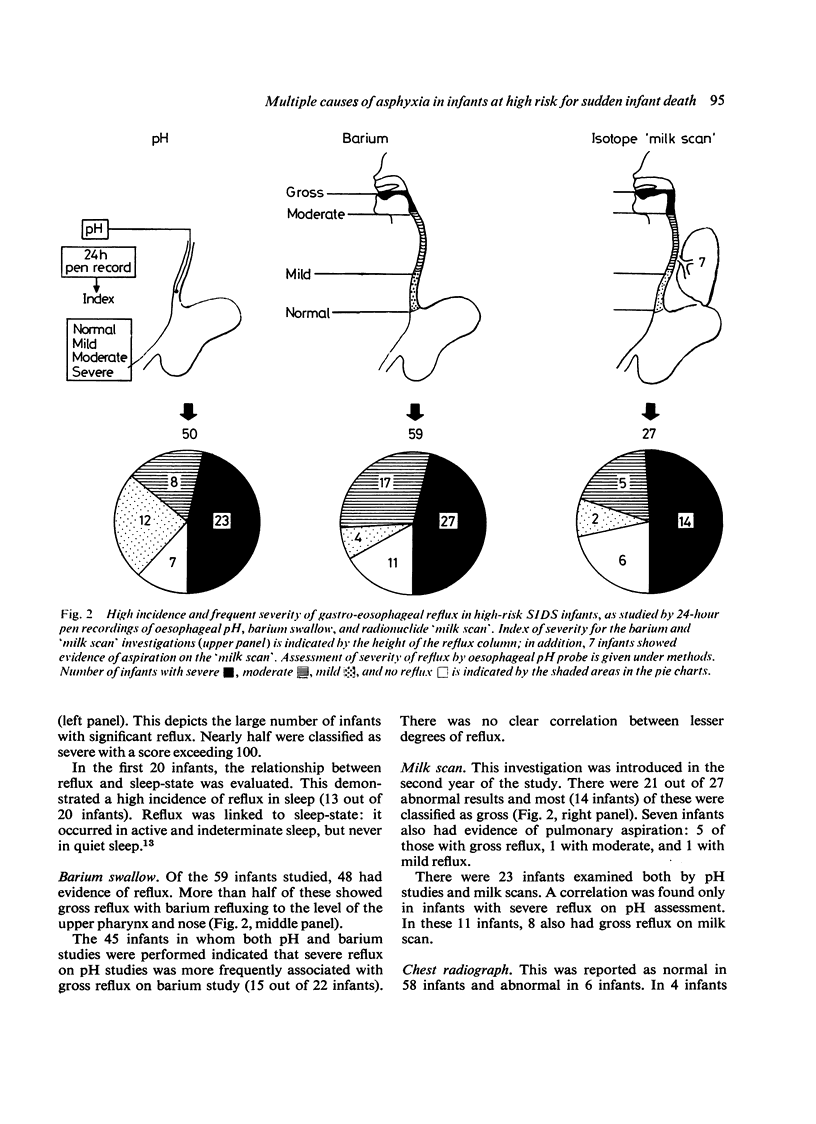
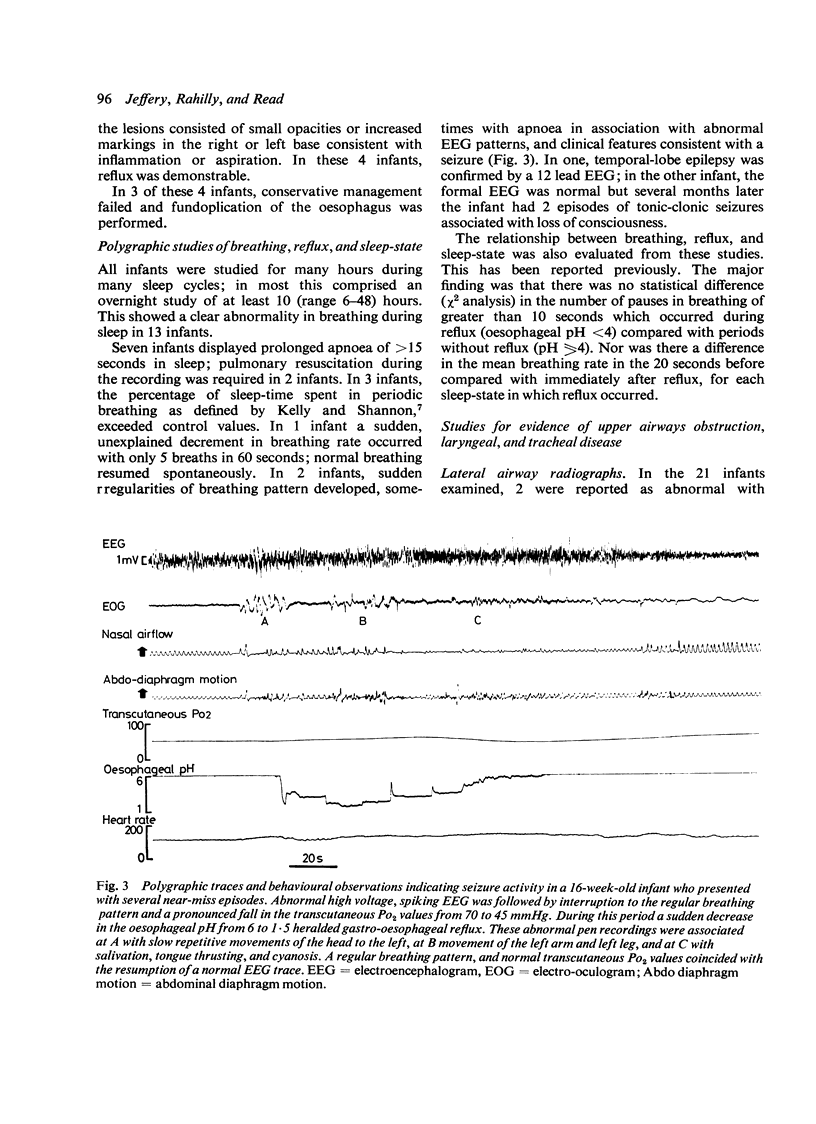
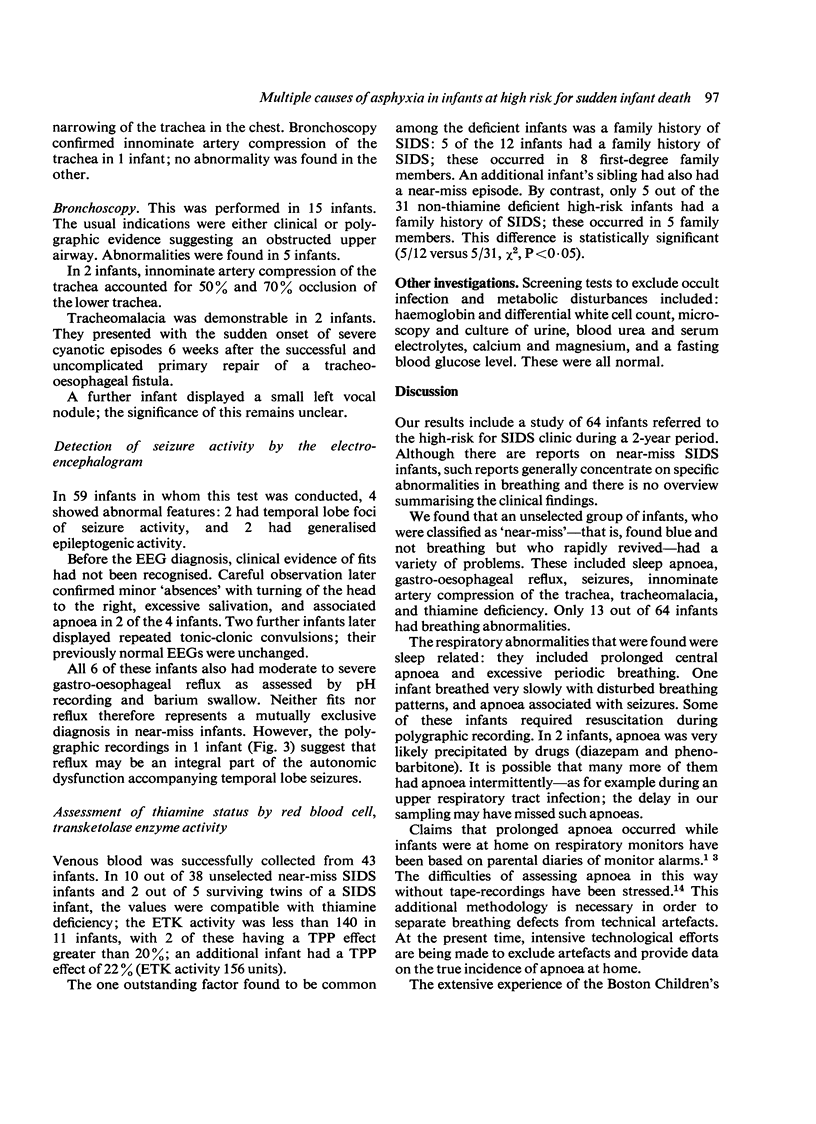
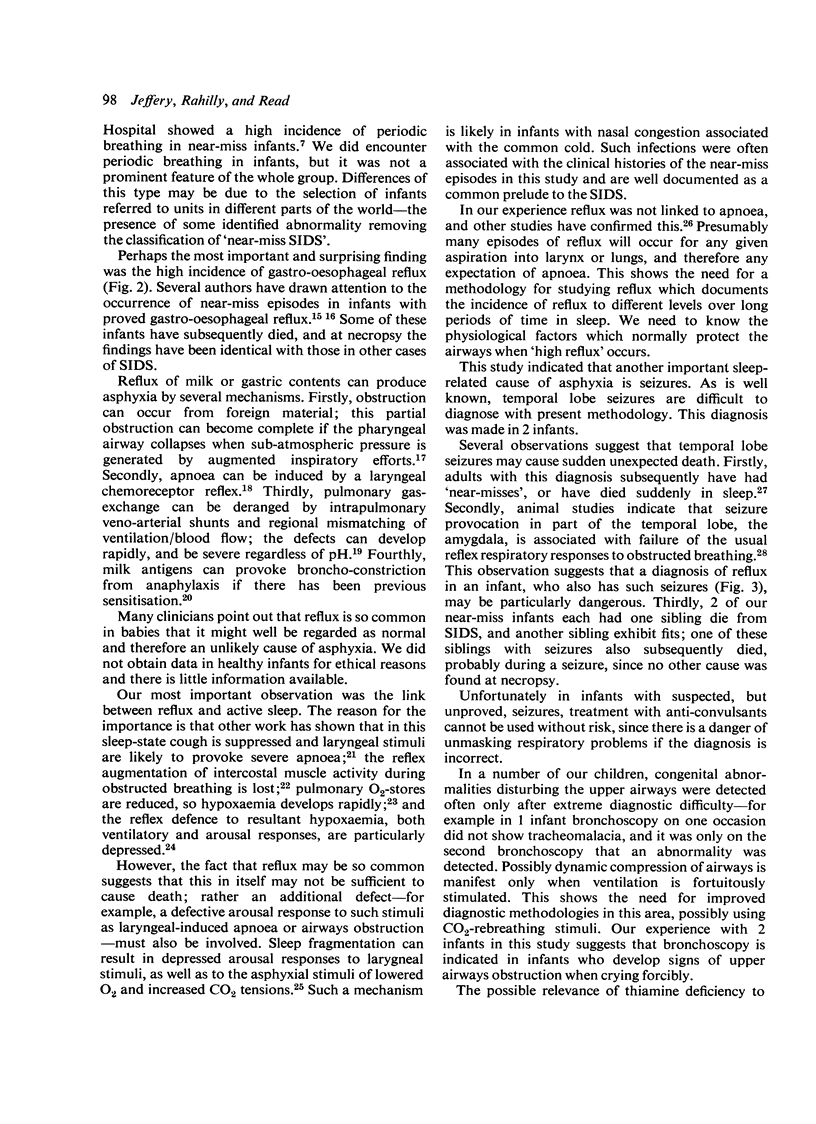
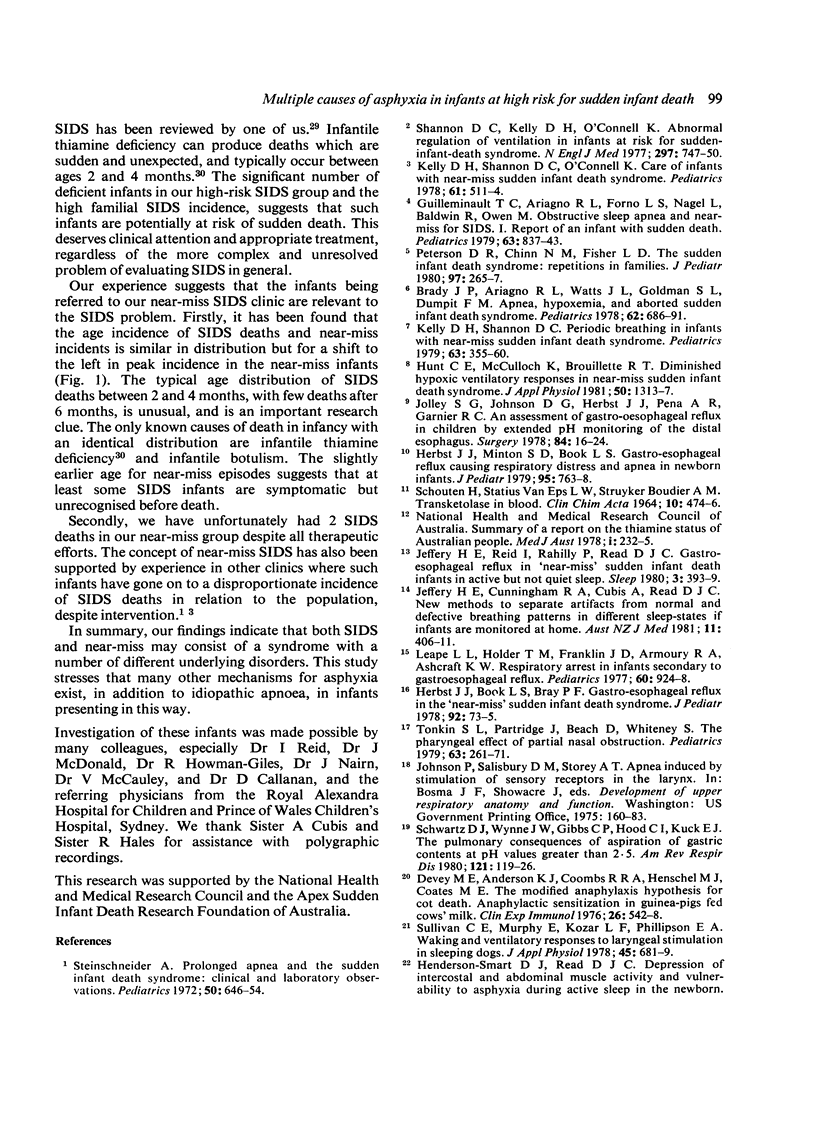
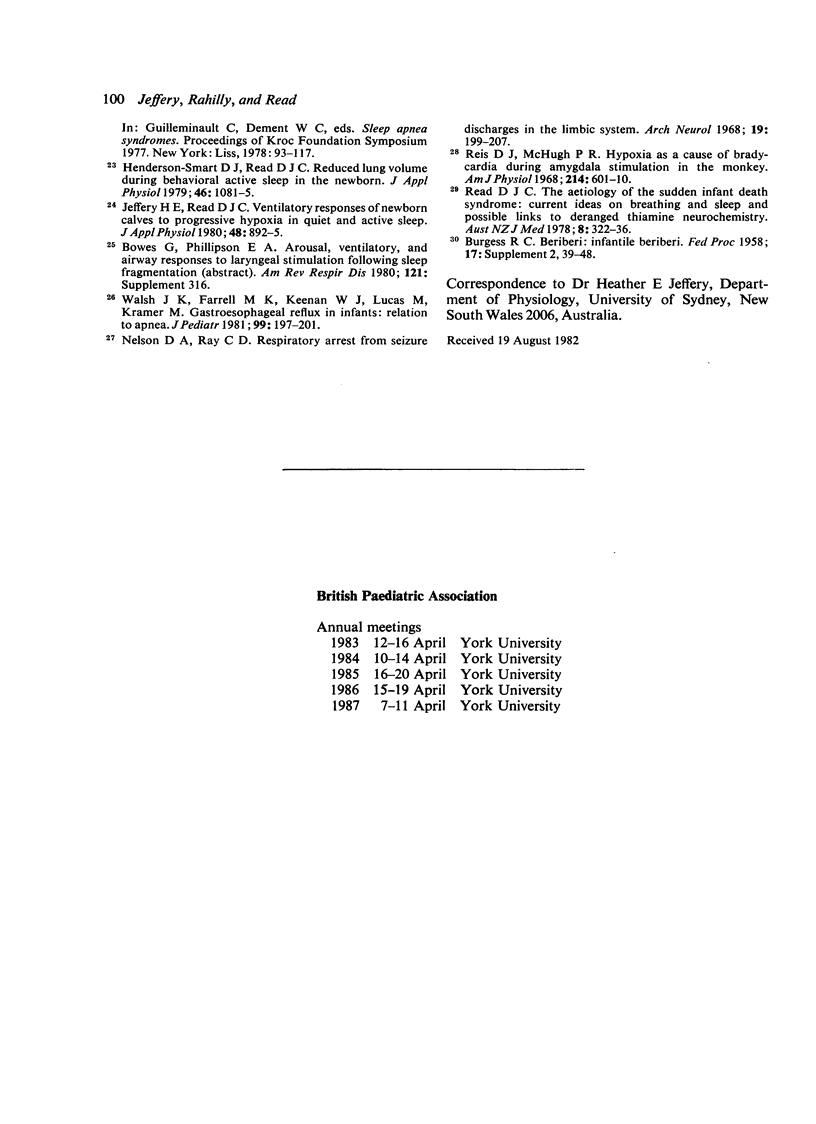
Selected References
These references are in PubMed. This may not be the complete list of references from this article.
- Brady J. P., Ariagno R. L., Watts J. L., Goldman S. L., Dumpit F. M. Apnea, hypoxemia, and aborted sudden infant death syndrome. Pediatrics. 1978 Nov;62(5):686–691. [PubMed] [Google Scholar]
- Devey M. E., Anderson K. J., Coombs R. R., Henschel M. J., Coates M. E. The modified anaphylaxis hypothesis for cot death. Anaphylactic sensitization in guinea-pigs fed cow's milk. Clin Exp Immunol. 1976 Dec;26(3):542–548. [PMC free article] [PubMed] [Google Scholar]
- Guilleminault C., Ariagno R. L., Forno L. S., Nagel L., Baldwin R., Owen M. Obstructive sleep apnea and near miss for SIDS: I. Report of an infant with sudden death. Pediatrics. 1979 Jun;63(6):837–843. [PubMed] [Google Scholar]
- Henderson-Smart D. J., Read D. J. Reduced lung volume during behavioral active sleep in the newborn. J Appl Physiol Respir Environ Exerc Physiol. 1979 Jun;46(6):1081–1085. doi: 10.1152/jappl.1979.46.6.1081. [DOI] [PubMed] [Google Scholar]
- Herbst J. J., Book L. S., Bray P. F. Gastroesophageal reflux in the "near miss" sudden infant death syndrome. J Pediatr. 1978 Jan;92(1):73–75. doi: 10.1016/s0022-3476(78)80074-2. [DOI] [PubMed] [Google Scholar]
- Herbst J. J., Minton S. D., Book L. S. Gastroesophageal reflux causing respiratory distress and apnea in newborn infants. J Pediatr. 1979 Nov;95(5 Pt 1):763–768. doi: 10.1016/s0022-3476(79)80733-7. [DOI] [PubMed] [Google Scholar]
- Hunt C. E., McCulloch K., Brouillette R. T. Diminished hypoxic ventilatory responses in near-miss sudden infant death syndrome. J Appl Physiol Respir Environ Exerc Physiol. 1981 Jun;50(6):1313–1317. doi: 10.1152/jappl.1981.50.6.1313. [DOI] [PubMed] [Google Scholar]
- Jeffery H. E., Read D. J. Ventilatory responses of newborn calves to progressive hypoxia in quiet and active sleep. J Appl Physiol Respir Environ Exerc Physiol. 1980 May;48(5):892–895. doi: 10.1152/jappl.1980.48.5.892. [DOI] [PubMed] [Google Scholar]
- Jeffery H. E., Reid I., Rahilly P., Read D. J. Gastro-esophageal reflux in "near-miss" sudden infant death infants in active but not quiet sleep. Sleep. 1980;3(3-4):393–399. doi: 10.1093/sleep/3.3-4.393. [DOI] [PubMed] [Google Scholar]
- Jeffery H., Cunningham R. A., Cubis A., Read D. J. New methods to separate artifacts from normal and defective breathing patterns in different sleep-states, if infants are monitored at home. Aust N Z J Med. 1981 Aug;11(4):406–411. doi: 10.1111/j.1445-5994.1981.tb03522.x. [DOI] [PubMed] [Google Scholar]
- Jolley S. G., Johnson D. G., Herbst J. J., Pena A., Garnier R. An assessment of gastroesophageal reflux in children by extended pH monitoring of the distal esophagus. Surgery. 1978 Jul;84(1):16–24. [PubMed] [Google Scholar]
- Kelly D. H., Shannon D. C., O'Connell K. Care of infants with near-miss sudden infant death syndrome. Pediatrics. 1978 Apr;61(4):511–514. [PubMed] [Google Scholar]
- Kelly D. H., Shannon D. C. Periodic breathing in infants with near-miss sudden infant death syndrome. Pediatrics. 1979 Mar;63(3):355–360. [PubMed] [Google Scholar]
- Leape L. L., Holder T. M., Franklin J. D., Amoury R. A., Ashcraft K. W. Respiratory arrest in infants secondary to gastroesophageal reflux. Pediatrics. 1977 Dec;60(6):924–928. [PubMed] [Google Scholar]
- Nelson D. A., Ray C. D. Respiratory arrest from seizure discharges in limbic system. Report of cases. Arch Neurol. 1968 Aug;19(2):199–207. doi: 10.1001/archneur.1968.00480020085008. [DOI] [PubMed] [Google Scholar]
- Peterson D. R., Chinn N. M., Fisher L. D. The sudden infant death syndrome: repetitions in families. J Pediatr. 1980 Aug;97(2):265–267. doi: 10.1016/s0022-3476(80)80491-4. [DOI] [PubMed] [Google Scholar]
- Read D. J. The aetiology of the sudden infant death syndrome: current ideas on breathing and sleep and possible links to deranged thiamine neurochemistry. Aust N Z J Med. 1978 Jun;8(3):322–336. doi: 10.1111/j.1445-5994.1978.tb04530.x. [DOI] [PubMed] [Google Scholar]
- Reis D. J., McHugh P. R. Hypoxia as a cause of bradycardia during amygdala stimulation in monkey. Am J Physiol. 1968 Mar;214(3):601–610. doi: 10.1152/ajplegacy.1968.214.3.601. [DOI] [PubMed] [Google Scholar]
- SCHOUTEN H., STATIUSVANEPS L. W., STRUYKERBOUDIER A. M. TRANSKETOLASE IN BLOOD. Clin Chim Acta. 1964 Nov;10:474–476. doi: 10.1016/0009-8981(64)90179-2. [DOI] [PubMed] [Google Scholar]
- Schwartz D. J., Wynne J. W., Gibbs C. P., Hood C. I., Kuck E. J. The pulmonary consequences of aspiration of gastric contents at pH values greater than 2.5. Am Rev Respir Dis. 1980 Jan;121(1):119–126. doi: 10.1164/arrd.1980.121.1.119. [DOI] [PubMed] [Google Scholar]
- Shannon D. C., Kelly D. H., O'Connell K. Abnormal regulation of ventilation in infants at risk for sudden-infant-death syndrome. N Engl J Med. 1977 Oct 6;297(14):747–750. doi: 10.1056/NEJM197710062971403. [DOI] [PubMed] [Google Scholar]
- Steinschneider A. Prolonged apnea and the sudden infant death syndrome: clinical and laboratory observations. Pediatrics. 1972 Oct;50(4):646–654. [PubMed] [Google Scholar]
- Sullivan C. E., Murphy E., Kozar L. F., Phillipson E. A. Waking and ventilatory responses to laryngeal stimulation in sleeping dogs. J Appl Physiol Respir Environ Exerc Physiol. 1978 Nov;45(5):681–689. doi: 10.1152/jappl.1978.45.5.681. [DOI] [PubMed] [Google Scholar]
- Tonkin S. L., Partridge J., Beach D., Whiteney S. The pharyngeal effect of partial nasal obstruction. Pediatrics. 1979 Feb;63(2):261–271. [PubMed] [Google Scholar]
- Walsh J. K., Farrell M. K., Keenan W. J., Lucas M., Kramer M. Gastroesophageal reflux in infants: relation to apnea. J Pediatr. 1981 Aug;99(2):197–201. doi: 10.1016/s0022-3476(81)80449-0. [DOI] [PubMed] [Google Scholar]


